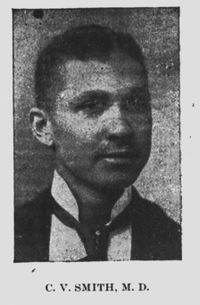Difference between revisions of "Charles V. Smith"
| (4 intermediate revisions by the same user not shown) | |||
| Line 1: | Line 1: | ||
{{Infobox Biography | {{Infobox Biography | ||
| subject_name = Charles V. Smith | | subject_name = Charles V. Smith | ||
| − | | image_name = | + | | image_name = Smithcvflasentinel1904.jpg |
| − | | image_size = | + | | image_size = 200px |
| − | | image_caption = | + | | image_caption = Dr. Smith in 1904 |
| date_of_birth = | | date_of_birth = | ||
| place_of_birth = | | place_of_birth = | ||
| Line 18: | Line 18: | ||
'''Charles V. Smith''' was one of the first black physicians to practice in Pensacola. | '''Charles V. Smith''' was one of the first black physicians to practice in Pensacola. | ||
| − | Smith had a daughter | + | A Pensacola native, Smith attended the famed [[Wikipedia:Tuskegee University|Tuskegee Institute]]. After graduating from [[Wikipedia:Meharry Medical College|Meharry Medical College]] in 1894, Smith practiced medicine in Georgia and South Florida before returning to Pensacola around 1899.<ref>Washington, Booker T. (1907). ''The Negro in Business'', p. 233. Hertel, Jenkins & Co., Chicago.</ref> By 1907, Smith had "the largest colored practice" in Pensacola, according to [[Wikipedia:Booker T. Washington|Booker T. Washington]], who mentioned Smith in his book ''The Negro in Business,'' describing Smith as "a specialist" who "is highly regarded in his community." |
| + | |||
| + | In 1912, Smith served as president of the Pensacola Negro Business League, an affiliate of the National Negro Business League established by Washington in 1900. Smith was instrumental in organizing Washington's [[March 1]], [[1912]] visit to Pensacola, presiding over the capacity crowd event at the [[Pensacola Opera House]]. | ||
| + | |||
| + | In 1918, Smith was commissioned as a first lieutenant in the Medical Reserve Corps of the U.S. Army.<ref>"Doings at Meharry College." Nashville Globe. 15 March 1918.</ref> That same year, Smith's daughter Lorine died of typhoid fever at the age of just 20.<ref>Florida Certificate of Death for Lorine E. Smith</ref> | ||
| + | |||
| + | Around 1922, Smith and his wife relocated to Cleveland, Ohio, but later returned to Pensacola. | ||
Dr. Smith died of a heart attack at his Pensacola residence, located at 306 East [[Chase Street]], in 1943.<ref>United States Deceased Physician File (AMA), 1864-1968</ref> | Dr. Smith died of a heart attack at his Pensacola residence, located at 306 East [[Chase Street]], in 1943.<ref>United States Deceased Physician File (AMA), 1864-1968</ref> | ||
| + | |||
| + | ==Other photos== | ||
| + | <gallery> | ||
| + | File:Smithdrcvresidenceflasentinel1904.jpg|thumb|Dr. Smith's longtime residence at 306 East Chase Street | ||
| + | </gallery> | ||
==References== | ==References== | ||
Latest revision as of 01:12, 20 March 2020
| Charles V. Smith | |
|---|---|
| Dr. Smith in 1904
| |
| Died | December 29, 1943 Pensacola, Florida |
| Occupation | Physician |
| Spouse | Hennie Smith |
| Children | Lorine Smith C. V. Smith, Jr. Gurie Smith Olga Smith |
Charles V. Smith was one of the first black physicians to practice in Pensacola.
A Pensacola native, Smith attended the famed Tuskegee Institute. After graduating from Meharry Medical College in 1894, Smith practiced medicine in Georgia and South Florida before returning to Pensacola around 1899.[1] By 1907, Smith had "the largest colored practice" in Pensacola, according to Booker T. Washington, who mentioned Smith in his book The Negro in Business, describing Smith as "a specialist" who "is highly regarded in his community."
In 1912, Smith served as president of the Pensacola Negro Business League, an affiliate of the National Negro Business League established by Washington in 1900. Smith was instrumental in organizing Washington's March 1, 1912 visit to Pensacola, presiding over the capacity crowd event at the Pensacola Opera House.
In 1918, Smith was commissioned as a first lieutenant in the Medical Reserve Corps of the U.S. Army.[2] That same year, Smith's daughter Lorine died of typhoid fever at the age of just 20.[3]
Around 1922, Smith and his wife relocated to Cleveland, Ohio, but later returned to Pensacola.
Dr. Smith died of a heart attack at his Pensacola residence, located at 306 East Chase Street, in 1943.[4]

